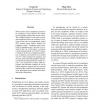Free Online Productivity Tools
i2Speak
i2Symbol
i2OCR
iTex2Img
iWeb2Print
iWeb2Shot
i2Type
iPdf2Split
iPdf2Merge
i2Bopomofo
i2Arabic
i2Style
i2Image
i2PDF
iLatex2Rtf
Sci2ools
ACL
2012
2012
Joint Learning of a Dual SMT System for Paraphrase Generation
SMT has been used in paraphrase generation by translating a source sentence into another (pivot) language and then back into the source. The resulting sentences can be used as candidate paraphrases of the source sentence. Existing work that uses two independently trained SMT systems cannot directly optimize the paraphrase results. Paraphrase criteria especially the paraphrase rate is not able to be ensured in that way. In this paper, we propose a joint learning method of two SMT systems to optimize the process of paraphrase generation. In addition, a revised BLEU score (called iBLEU) which measures the adequacy and diversity of the generated paraphrase sentence is proposed for tuning parameters in SMT systems. Our experiments on NIST 2008 testing data with automatic evaluation as well as human judgments suggest that the proposed method is able to enhance the paraphrase quality by adjusting between semantic equivalency and surface dissimilarity.
| Added | 29 Sep 2012 |
| Updated | 29 Sep 2012 |
| Type | Journal |
| Year | 2012 |
| Where | ACL |
| Authors | Hong Sun, Ming Zhou |
Comments (0)

